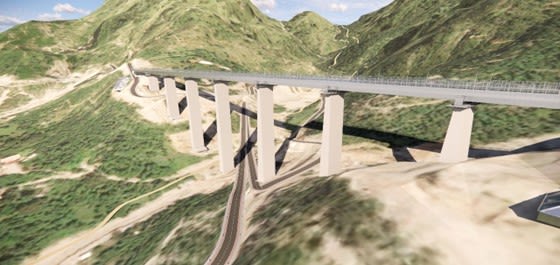




Overview
The Udhampur-Srinagar-Baramulla Rail Link (USBRL) project is of national importance as it connects Kashmir to the rest of India with an all-weather transport link. Given the frequent disruptions in the road link that presently serves this purpose—particularly during the winter—the rail link is a much-awaited project for the region. This case study describes the monitoring solution for two of the 24 bridges in the complete project: Bridge 39 and Bridge 43.
Bridge 39
Bridge 39 is an engineering marvel that spans approximately 490 m (1,607.6 ft) with tall, tapered, rectangular piers that are hollow. The supporting piers are spaced 53.15 m (174.38 ft) on each end and 64 m (209.97 ft) between each of the five interior piers. The double line Reasi station yard is located on this bridge. The superstructure of the bridge is a continuous composite steel girder.
Bridge 43
Bridge 43 is 777 m (2,549.2 ft) long with a span arrangement of 35 m (114.83 ft), 53 m (173.88 ft), ten 64-m (209.97-ft) spans, and then 49 m (160.76 ft). The double line Salal station yard is located on this bridge. The superstructure of the bridge is also a continuous composite steel girder. A bridge section of 497 m (1,637 ft) is straight with a curved section of 287 m (941.6 ft).
Bridges 39 and 43
The performance specification of the structural health monitoring (SHM) and maintenance management system (MMS) is based on the Konkan Railway Corporation Limited (KRCL) reference. The SHM and MMS maintain the functional requirements of the KRCL reference design for SHM and MMS, but include nine enhancements:
- Direct monitoring (stress and strain) of bonded internal post-tensioned (U-shaped vertical) tendons in pier segments
- Direct monitoring (stress and strain) of simply supported I-girders in deck segments
- Direct monitoring of environmental parameters using wind data for controlling train movement operations
- Accelerometer usage to monitor effects on bridge from high-speed impacts and seismic activity
- Monitoring of cross-girders at piers
- Enhanced strain monitoring at mid-spans for deflection derivation
Campbell Scientific’s SHM system monitors the long-term, dynamic status and health of the KRCL reference design. The CR6—a multifunctional measurement and control unit—is used as the core data-acquisition unit (DAQ) for the vibrating wire-type sensors used in bridge monitoring. The DAQ collects and detects the signal condition of vibrating wire strain gauges, vibrating wire load cells, temperature sensors, and 3D servo-type accelerometers.
In total, the SHM system uses four CR6 units, two CR1000X units, two CR800 units, six VOLT116 units, and eight AM16/32B expansion peripherals to measure more than 500 sensors in total. The data from these DAQs have been transmitted to a common control room using optical fiber. This combination of sensors, data acquisition, and data transmission will help decision-makers ensure the bridge’s integrity and longevity and provide necessary maintenance.
A significant portion of the SHM data includes structural strain and load cell measurements from more than 200 vibrating wire sensors. These sensors are measured by the Campbell Scientific CR6 to provide simultaneous, noise-free data using the patented VSPECT® technology.
Conclusion
The USBRL project is a transformative infrastructure initiative that provides a reliable, all-weather transport link between Kashmir and the rest of India—eliminating the frequent disruptions caused by weather-sensitive roadways. The deployment of Campbell Scientific’s advanced SHM system on key bridges such as Bridge 39 and Bridge 43 plays a critical role to ensure the long-term safety, stability, and functionality of this vital rail corridor. By continuously monitoring load, strain, vibration, environmental factors, and potential structural weaknesses, the SHM system enables proactive maintenance and immediate response to emerging risks, thereby minimizing downtime and enhancing operational reliability. As the project progresses, integrating these intelligent monitoring systems across additional bridges will strengthen the resilience of the entire rail network and support uninterrupted connectivity for generations to come.
Case Study Summary
Application
Monitoring an all-weather transport link that connects a region to the rest of the countryLocation
Reasi, Jammu, IndiaProducts Used
CR800 CR1000X LoggerNet GRANITE VOLT 116 AM16/32B CR6Contributors
Campbell Scientific India regional officeParticipating Organisations
Northern Railway, KRCL, RITES Limited, PMT Infrascience Pvt. Ltd.Measured Parameters
Tilt, vibration, static and dynamic strain, load, displacement, deflection, rainfall, wind speed and direction, humidity, air temperature, barometric pressureView the PDF